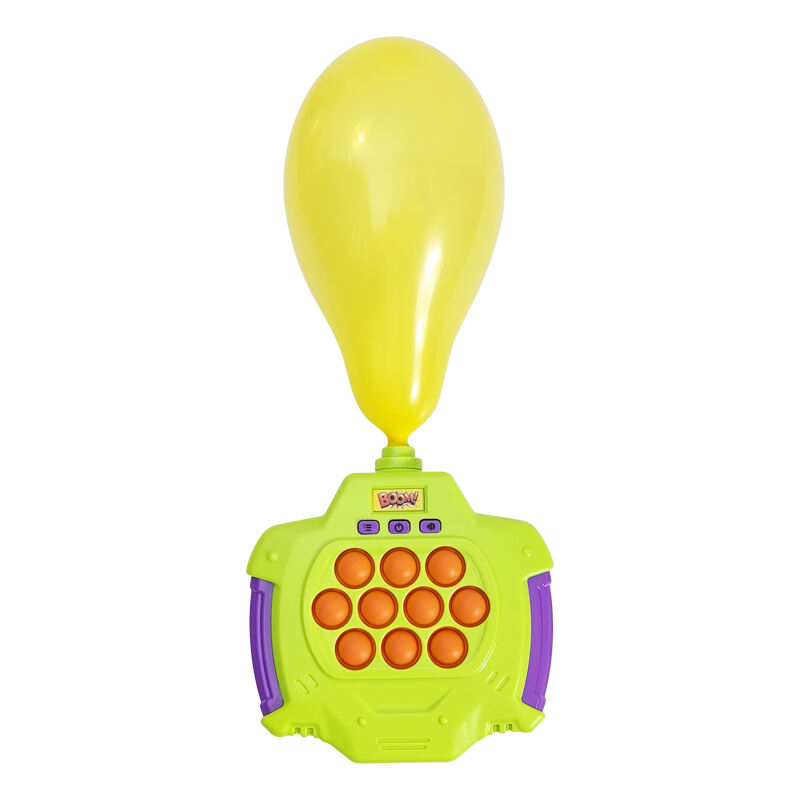Cognitive Development Through Interactive Toys
Understanding Cause and Effect Learning in Early Childhood
Toys that respond when touched are great for teaching basic thinking skills such as cause and effect because they give kids something back right away. Think about what happens when little ones push buttons and see lights come on or turn gears and hear music play. They start making connections between what they do and what happens next, which is super important for developing logical thinking down the road. A study published last year in the Early Learning Journal found pretty interesting results too. Kids who played with these interactive toys recognized patterns about 40 percent quicker than those just sitting around watching others play. Some experts even call these toys "thinking mirrors" since they bounce things back so fast, helping tiny brains wrap around tricky ideas that might otherwise seem impossible to understand.
How Interactive Toys Enhance Memory, Focus, and Problem-Solving Skills
Things like puzzles, sequencing activities, and building sets really push kids to remember stuff, plan ahead, and adjust their thinking on the fly these are basically the building blocks for getting ready for school work. When kids play memory matching games, they get better at remembering where things go. Shape sorters help them figure out how objects fit together through lots of trying different approaches. Studies show that when kids engage in this kind of active play regularly, their ability to focus tends to stretch about 23 extra minutes on average. The reason? Kids stay interested because they get immediate responses when they solve problems, which makes them want to keep going.
Evidence-Based Impact: 78% Improvement in Memory Retention with Smart Learning Tablets
New tech in education is showing some pretty impressive results when it comes to how kids think and learn. Researchers ran a test last year on around 450 little ones in preschool classrooms across the country. They discovered something interesting about these smart learning tablets powered by artificial intelligence. Kids who used them remembered things better after just half a year compared to regular teaching methods. The tablets adjust what each child sees based on how they're doing, making sure no one gets stuck or bored. What makes these devices work so well? They employ this clever technique called spaced repetition where important ideas come back at just the right moments. Preschoolers actually solved those tricky logic problems almost three times quicker than kids playing with standard plastic toys. According to findings shared by experts at the Child Development Institute, there's growing evidence that when children engage with interactive materials rather than passive activities, their brains develop stronger memory skills over time.
Building Motor Skills with Movement-Based and Hands-On Interactive Toys
Fine Motor Development Through Puzzles, Building Blocks, and Touch-Sensitive Toys
Toys that need careful hand movements like those shape sorting puzzles, magnetic building blocks, and interactive tablets help develop grip strength, fine motor skills, and coordination between hands and eyes. When kids handle tiny pieces they're actually working on the little muscles in their fingers and palms that will later be so important for holding pencils and doing everyday stuff. According to research published last year in Child Development, babies who played with these kinds of hands-on toys improved at precision tasks around 22 percent quicker than those just playing with regular toys. Newer tech toys such as those glowing tracing boards give immediate responses when touched, helping children learn how their actions affect what happens next while also practicing better control over their movements.
Gross Motor Coordination Using Active Play Toys Like Motion-Sensing Games
Toys that get kids moving around, such as those dance floors where they follow light patterns, balls that track movement through the air, and obstacle courses that require crawling or balancing, really work the whole body. Kids pick up on balance, how their limbs move together, and where they are in space while having fun. Research shows when little ones jump around, toss objects back and forth, or change directions quickly during play, their sense of where their bodies are improves quite a bit actually about 37 percent according to some recent studies on preschool age children. What makes these toys special is how they turn exercise into something enjoyable rather than just another chore. The kind of games that sync with music beats help even more with figuring out rhythms and using both sides of the body at once something parents often notice when watching their kids play.
Supporting Social and Emotional Growth via Interactive Play
Interactive toys can really help kids build emotional smarts and get along better with others. When little ones play together with these kinds of toys, they start learning how to read what's going on with their friends through the toy's responses. They also pick up on taking turns naturally as they interact. Research from the Mt. Sinai Child Development Center back in 2023 showed something interesting too. Kids who played with interactive toys in groups ended up being 34% more cooperative than those playing alone. That makes sense when we think about it because working out disagreements and seeing things from different angles becomes second nature through this kind of play experience.
Developing Empathy and Cooperation Through Shared Play With Responsive Toys
Toys requiring collaborative input – such as sound-activated story cubes or emotion-recognition games – create natural opportunities for children to practice sharing and recognize nonverbal social cues. These interactions mirror real-world dynamics, allowing preschoolers to experiment with compromise and joint problem-solving in low-pressure environments.
Emotional Regulation and Confidence Building Using Role-Playing and Storytelling Dolls
Role-play toys with scenario-based feedback help children process complex feelings while building self-assurance. Research from Inclusive Teach shows children using interactive storytelling dolls demonstrated 28% faster emotional vocabulary acquisition compared to non-interactive play, enabling clearer expression of frustrations and joys.
Case Study: Reducing Anxiety in Preschoolers With Interactive Companion Toys
Educators observed decreased separation anxiety in 72% of children when introduced to programmable companion toys during transitional periods. These adaptive tools provided consistent emotional reassurance while teaching self-soothing techniques through guided breathing exercises and calming tactile interactions.
Accelerating Language Acquisition with Talking, Singing, and AI-Powered Interactive Toys
How Sound-Responsive Toys Support Vocabulary and Pronunciation Milestones
Toys that make sounds really help kids link what they hear with actual words and language through repeated exposure and instant responses. Research from Gogofun Learning back in 2024 found something interesting about these interactive toys. When they combine picture recognition with spoken words, like those sound books showing animals alongside their names being said out loud, kids remember vocabulary around 40% better than just hearing words passively. What makes these toys so effective is that they engage multiple senses at once. Toddlers can copy how words sound properly because they see the corresponding images while hearing them spoken, which helps build their understanding of different speech sounds over time.
Trend Analysis: AI-Driven Bilingual Toys Shaping Early Language Development
New AI tech is changing how kids learn languages through smart bilingual toys that change what they offer depending on how well the child is doing. Take conversational AI tutors for instance they tailor their chats with kids, bringing in new vocabulary when appropriate and fixing pronunciation mistakes as they happen. Some studies show that kids who play with these gadgets tend to know about 20% more words at four years old compared to those sticking with old school methods according to Vocal Media Futurism from last year. With improvements in natural language processing, or NLP as experts call it, these educational toys now handle switching between languages much better too. This helps little ones get ready for situations where multiple languages are spoken around them every day.
Choosing the Right Interactive Toys by Age, Safety, and Educational Value
Matching Interactive Toys to Developmental Stages: A Guide for Toddlers and Preschoolers
When interactive toys align with what kids can do at different stages of development, they tend to offer the most learning benefits. For babies just starting to understand that objects exist even when out of sight, textured balls and those little pop-up roller toys really help build that concept. Preschoolers on the other hand get something different from their playthings. Things like puzzle sequences or simple coding robots actually boost their ability to solve problems before they even know what problem solving is. Some research from last year looked into this whole matching toys to developmental stages thing. The results were pretty interesting too. Kids who played with toys suited for their age group made progress in spatial thinking almost three times faster than those stuck with toys that didn't fit where they were developmentally.
Key Criteria: Safety, Durability, Screen-Time Balance, and STEM Alignment
Four essential factors govern smart interactive toy selection:
- Safety: Prioritize ASTM/EN71-certified toys with rounded edges and BPA-free materials
- Durability: Opt for reinforced joints on robotic toys and waterproof coatings on touch-sensitive panels
- Engagement Balance: Limit screen-based toys to 30% of playtime, favoring tactile STEM kits like magnetic building systems
- Educational ROI: Choose toys reinforcing concepts through multiple modalities, like alphabet pianos blending sound, touch, and visual feedback
Leading child development researchers emphasize that combining these criteria creates play environments where interactive toys amplify — rather than replace — organic learning opportunities.
FAQs About Interactive Toys and Child Development
What age is suitable for interactive toys?
Interactive toys are suitable for a wide range of ages, from infants to preschoolers, with each type of toy catering to different developmental stages and needs.
Do interactive toys help with learning?
Yes, interactive toys promote cognitive, motor, and emotional development by engaging children in active play that supports memory, problem-solving, social skills, and language acquisition.
Are interactive toys safe for young children?
When choosing interactive toys, prioritize those that are certified for safety standards like ASTM/EN71, have rounded edges, and are made from BPA-free materials.
How do interactive toys support language development?
Interactive toys often combine sound and visuals to help children associate spoken words with images, improving vocabulary and pronunciation through multisensory engagement.
Why are AI-powered toys beneficial for early learning?
AI-powered toys adjust their learning content based on a child's progress, offering personalized learning experiences that encourage language and problem-solving skills.
Table of Contents
- Cognitive Development Through Interactive Toys
- Building Motor Skills with Movement-Based and Hands-On Interactive Toys
- Supporting Social and Emotional Growth via Interactive Play
- Accelerating Language Acquisition with Talking, Singing, and AI-Powered Interactive Toys
- Choosing the Right Interactive Toys by Age, Safety, and Educational Value
- FAQs About Interactive Toys and Child Development

